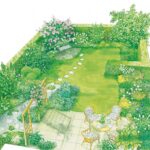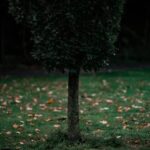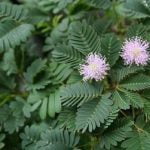Are you struggling to design a small shady garden? Finding the right garden design ideas for small shady gardens can be a challenge, but with the right approach, it is possible to create a beautiful and functional outdoor space. This article will provide valuable tips and inspiration for transforming your small shady garden into a lush and inviting retreat.
Designing a small shady garden comes with its own unique set of challenges. Limited sunlight, soil quality, and limited space can make it difficult to create an appealing outdoor environment. However, by carefully assessing the space and choosing the right plants and design elements, you can maximize the potential of your small shady garden.
In this article, we will explore various strategies for designing small shady gardens, including selecting shade-loving plants, creating vertical interest, incorporating shade structures, maximizing functionality, embracing texture and color, and implementing low-maintenance design ideas. Whether you have a tiny urban courtyard or a compact backyard with limited sun exposure, we have got you covered with practical advice and creative solutions for making the most of your small shady garden.
Assessing the Space
When it comes to designing a small shady garden, assessing the space is crucial for ensuring the success of the design. Sun exposure, soil quality, and existing plant life all play important roles in creating a thriving garden in shaded areas. Before implementing any garden design ideas for small shady gardens, it’s essential to evaluate the available space to make informed decisions about plant selection and layout.
One of the first considerations when assessing a small shady garden is sun exposure. While these areas may receive minimal direct sunlight, it’s important to note any pockets of sunlight that filter through the shade. This information will be essential for choosing plants that can thrive in low light conditions while still receiving necessary sun exposure.
Soil quality is another important factor when evaluating a small shady garden. Shaded areas may have different soil compositions and moisture levels than sunny locations, so it’s important to assess the soil to determine if any amendments are needed. Adding organic matter or specialized fertilizers can help improve soil quality and provide an optimal environment for shade-loving plants.
Existing plant life in a small shady garden should also be evaluated before implementing new design ideas. Understanding what is already growing in the space will help determine which additional plants will complement the existing ones and create a cohesive overall design.
Additionally, identifying any invasive species or aggressive plants will be crucial for maintaining balance and preventing overcrowding in limited shaded spaces. By carefully assessing these key elements, gardeners can make informed decisions when selecting plants and designing layouts for small shady gardens.
Choosing the Right Plants
When it comes to garden design ideas for small shady gardens, choosing the right plants is crucial for creating a lush and thriving outdoor space. In small shady gardens, it can be challenging to find plants that will flourish without direct sunlight. However, there are several shade-loving plants that are well-suited for small spaces and can add beauty and interest to the garden.
Here are some shade-loving plants that thrive in small spaces:
- Ferns: Ferns are classic shade-loving plants that come in a variety of shapes, sizes, and textures. They are perfect for adding a touch of greenery to a small shady garden and can thrive in areas with limited light.
- Hostas: Hostas are known for their attractive foliage and their ability to thrive in shady conditions. These versatile plants come in a wide range of colors and patterns, making them an excellent choice for adding visual interest to a small garden.
- Astilbes: Astilbes are prized for their feathery plumes of flowers and their ability to tolerate shade. These colorful perennials can add a pop of color to a small shady garden and are relatively low-maintenance.
By choosing shade-loving plants like ferns, hostas, and astilbes, you can create a beautiful and thriving garden even in areas with limited sunlight. These plants not only add visual appeal but also contribute to the overall health and vitality of your small shady garden.
In addition to these well-loved options, there is also an array of other shade-loving plants that can be combined creatively to achieve varied textures as well as complementing colors within your shaded space.
Creating Vertical Interest
When designing a small shady garden, it’s important to maximize the available space and add visual interest to create an inviting outdoor space. One effective way to achieve this is by exploring vertical garden options such as trellises, arbors, and hanging planters. These elements not only maximize space but also add a unique aesthetic appeal to the garden.
Using Trellises
Trellises are a versatile and visually appealing addition to a small shady garden. They can be used to support climbing plants such as ivy, clematis, or climbing roses, adding height and dimension to the garden while making use of vertical space. When selecting trellises for a small shady garden, consider the size and scale of the space as well as the design style of the garden to ensure a cohesive look.
Arbors for Shade-Loving Vines
Arbors not only provide structural interest but also offer a charming entrance or focal point in a small shady garden. When adorned with shade-loving vines such as wisteria or jasmine, arbors can create a shaded retreat within the garden. The addition of an arbor adds vertical depth to the space while offering support for lush greenery that thrives in shady conditions.
Hanging Planters for Vertical Gardens
Incorporating hanging planters is another effective way to make use of vertical space in a small shady garden. These planters can be hung from pergolas, tree branches, or designated structures to elevate plants off the ground and create visual interest at varying heights throughout the garden. Consider using trailing plants like ferns or spider plants for added visual impact in shaded areas.
By incorporating these vertical garden options into a small shady garden design, you can make the most of limited space while adding visual appeal and greenery to transform your outdoor oasis. These elements not only maximize space but also provide opportunities for creativity and personalization in garden design ideas for small shady gardens.
Incorporating Shade Structures
When designing a small shady garden, it’s important to consider how to incorporate shade structures to provide relief from the sun and create a comfortable outdoor living area. One of the most popular options for creating shade in a small garden is the use of pergolas.
These wooden or metal structures not only provide shade but also add architectural interest to the space. Pergolas can be adorned with climbing plants such as wisteria or clematis, adding charm and color to the garden.
Another option for providing shade in a small garden is through the use of umbrellas. Patio umbrellas come in various sizes and designs, making them easy to customize based on the specific needs and style of the garden. In addition to providing shade, umbrellas can also serve as a focal point or pop of color in a small shady garden.
Shade sails are another versatile option for creating shaded areas in small gardens. These fabric canopies come in a variety of shapes and sizes, allowing for flexibility in design. Shade sails not only provide relief from the sun but also add a modern and stylish element to the garden. When choosing shade structures for a small shady garden, it’s important to consider both functionality and aesthetics, ensuring that they complement the overall design and enhance the outdoor living space.
| Shade Structure | Benefits |
|---|---|
| Pergolas | Provide architectural interest; Can be adorned with climbing plants |
| Umbrellas | Customizable; Add pop of color; Serve as focal point |
| Shade Sails | Versatile; Modern design element; Provide relief from sun |
Maximizing Functionality
Designing a small shady garden can be challenging, but with the right garden design ideas for small shady gardens, it is possible to create a beautiful and functional outdoor space. One important aspect of maximizing functionality in a small shady garden is to carefully plan the layout to make the most of the available space. By incorporating seating, pathways, and outdoor lighting, you can create a comfortable and inviting atmosphere for relaxing and entertaining.
When it comes to seating in a small shady garden, consider options that are both functional and space-saving. This could include compact bistro sets, foldable chairs, or built-in benches along the perimeter of the garden. Utilizing multi-functional furniture, such as storage benches that double as seating, can also help maximize space in a small shady garden.
Pathways are another important consideration when designing a small shady garden. They not only provide practical access to different areas of the garden but also add visual interest and structure. Consider using materials like gravel, stepping stones, or natural wood planks to create winding paths that lead visitors through the garden while maximizing space.
Incorporating outdoor lighting is essential for making the most of a small shady garden, especially for evening enjoyment. Consider using solar-powered stake lights along pathways or string lights overhead to create ambiance and extend the time spent outdoors.
Additionally, strategically placed lanterns or torches can add both light and style to your small shady garden design. By carefully planning seating, pathways, and outdoor lighting in your small shady garden design, you can transform even the smallest shaded spaces into beautiful and functional outdoor retreats.
- Seating
- Compact bistro sets
- Foldable chairs
- Built-in benches
- Multi-functional furniture
- Pathways
- Gravel paths
- Stepping stone walkways
- Natural wood plank trails
- Outdoor Lighting
- Solar-powered stake lights
- String lights overhead
- Lanterns or torches
Embracing Texture and Color
When it comes to small shady gardens, finding ways to add visual interest is essential for creating a vibrant and inviting outdoor space. Embracing texture and color through the use of varied foliage, flowers, and decorative elements can elevate the design of a small shady garden, making it a delightful and captivating area to enjoy.
Varied Foliage
One effective way to add visual interest in a small shady garden is by incorporating a variety of foliage. Consider plants with different leaf shapes, sizes, and textures to create depth and dimension within the garden. For example, mix large-leaved plants like hostas with delicate ferns to create an intriguing contrast in foliage.
Strategic Use of Flowers
While shade-loving plants may not bloom as abundantly as sun-loving ones, there are still plenty of flowering options for small shady gardens. Look for colorful blooms that thrive in low-light conditions, such as impatiens, begonias, and bleeding hearts. Strategically place these blooms throughout the garden to add pops of color and enhance visual appeal.
Decorative Elements
In addition to plants, incorporating decorative elements can also enhance the visual interest of a small shady garden. Consider adding ornamental features like statues, birdbaths, or unique planters to create focal points within the space. These elements not only add aesthetic value but also contribute to the overall charm of the garden design.
By embracing texture and color through varied foliage, strategic use of flowers, and decorative elements, it’s possible to create a visually stunning small shady garden that feels dynamic and engaging. With careful planning and attention to detail, even the smallest of spaces can be transformed into a lush and captivating outdoor retreat.
Low-Maintenance Design Ideas
In conclusion, designing a small shady garden comes with its own set of challenges, but with the right garden design ideas for small shady gardens, it can be transformed into a beautiful and functional outdoor space. Assessing the space is crucial, as it helps in understanding the specific needs of the garden, including sun exposure, soil quality, and existing plant life.
Once these factors are evaluated, choosing the right shade-loving plants such as ferns, hostas, and astilbes will ensure a thriving garden in limited space.
Additionally, creating vertical interest with trellises, arbors, and hanging planters can maximize space and add visual appeal to the small shady garden. Incorporating shade structures like pergolas, umbrellas, and shade sails not only provide relief from the sun but also create a comfortable outdoor living area for relaxation. It is also important to consider functionality by incorporating seating areas, pathways, and outdoor lighting to make the most of the space.
Embracing texture and color through varied foliage, flowers, and decorative elements can add visual interest to the garden. Lastly, low-maintenance design ideas such as ground cover plants and mulch should be incorporated to keep small shady gardens looking their best with minimal upkeep. By implementing these various design ideas for small shady gardens, even the smallest of spaces can be transformed into a lush green oasis that serves as a peaceful retreat from everyday life.
Frequently Asked Questions
How Do You Landscape a Shade Garden?
Landscaping a shade garden requires careful selection of plants that thrive in low light conditions. Look for shade-loving plants like hostas, ferns, and coral bells. Consider adding paths or seating areas to make the space inviting.
How Do I Make a Garden in My Shaded Yard?
Creating a garden in a shaded yard can be done by choosing plants that do well in low light, such as impatiens, astilbe, and foxglove. Adding layers of mulch can help retain moisture in the soil.
How Do You Enjoy a Shady Garden?
Enjoying a shady garden involves finding ways to make the most of the limited sunlight. Consider installing a comfortable seating area where you can relax and take in the beauty of your garden. Embrace the serene and cool atmosphere that a shaded garden provides.

Welcome to my gardening blog! I am passionate about plants and enjoy sharing my knowledge and experiences with others. In this blog, I will write about everything related to gardening, from tips on how to get started to updates on my own garden projects.





